Applying Structural Principles to Low-Rise Construction Report
VerifiedAdded on 2022/11/22
|14
|2525
|109
Report
AI Summary
This report comprehensively analyzes the application of structural principles in residential low-rise construction, specifically focusing on stiffened raft ground slabs and suspended slabs. It details the construction process, including excavation methods, site preparation, formwork setup, reinforcement (mesh and bars), plastic products, concrete types (strength grade, aggregate size, slump), concrete pouring methods, and curing processes. The report references AS2870 and includes images with headings and relevant text for each step of the construction, from initial excavation to the final curing stage. It discusses the steel reinforcement used, lapping requirements, precautions during concrete pouring, and the importance of concrete curing for durability and strength enhancement. The report also covers different types of concrete slabs (insitu, composite, and precast) and the materials used, such as ordinary Portland cement and various aggregates, providing a detailed overview of the construction process. This report is presented in a professional format, meeting the requirements of the assignment brief, and is designed to provide insights into the construction of residential slabs.
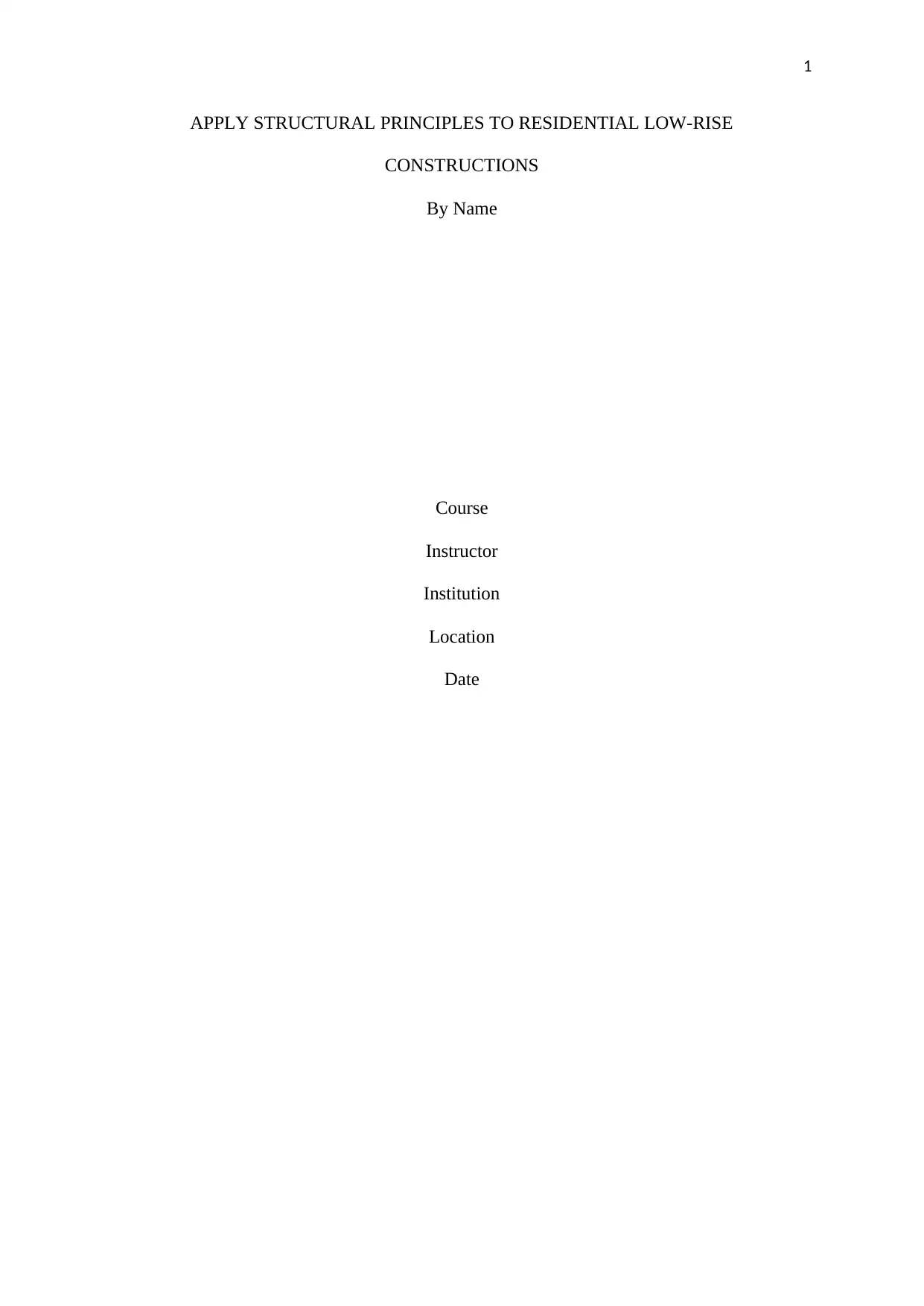
1
APPLY STRUCTURAL PRINCIPLES TO RESIDENTIAL LOW-RISE
CONSTRUCTIONS
By Name
Course
Instructor
Institution
Location
Date
APPLY STRUCTURAL PRINCIPLES TO RESIDENTIAL LOW-RISE
CONSTRUCTIONS
By Name
Course
Instructor
Institution
Location
Date
Paraphrase This Document
Need a fresh take? Get an instant paraphrase of this document with our AI Paraphraser
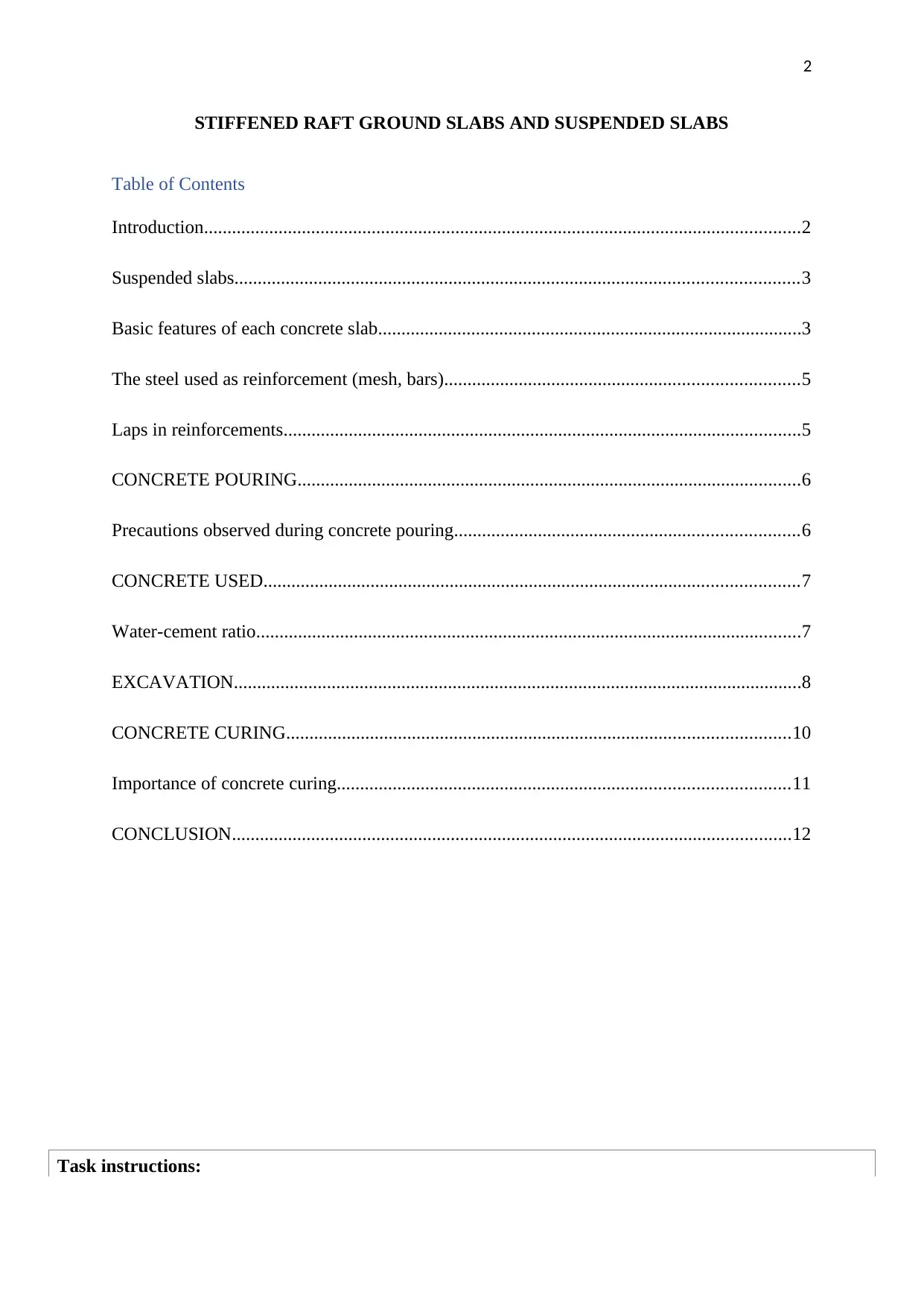
2
STIFFENED RAFT GROUND SLABS AND SUSPENDED SLABS
Table of Contents
Introduction................................................................................................................................2
Suspended slabs.........................................................................................................................3
Basic features of each concrete slab...........................................................................................3
The steel used as reinforcement (mesh, bars)............................................................................5
Laps in reinforcements...............................................................................................................5
CONCRETE POURING............................................................................................................6
Precautions observed during concrete pouring..........................................................................6
CONCRETE USED...................................................................................................................7
Water-cement ratio.....................................................................................................................7
EXCAVATION..........................................................................................................................8
CONCRETE CURING............................................................................................................10
Importance of concrete curing.................................................................................................11
CONCLUSION........................................................................................................................12
Task instructions:
STIFFENED RAFT GROUND SLABS AND SUSPENDED SLABS
Table of Contents
Introduction................................................................................................................................2
Suspended slabs.........................................................................................................................3
Basic features of each concrete slab...........................................................................................3
The steel used as reinforcement (mesh, bars)............................................................................5
Laps in reinforcements...............................................................................................................5
CONCRETE POURING............................................................................................................6
Precautions observed during concrete pouring..........................................................................6
CONCRETE USED...................................................................................................................7
Water-cement ratio.....................................................................................................................7
EXCAVATION..........................................................................................................................8
CONCRETE CURING............................................................................................................10
Importance of concrete curing.................................................................................................11
CONCLUSION........................................................................................................................12
Task instructions:
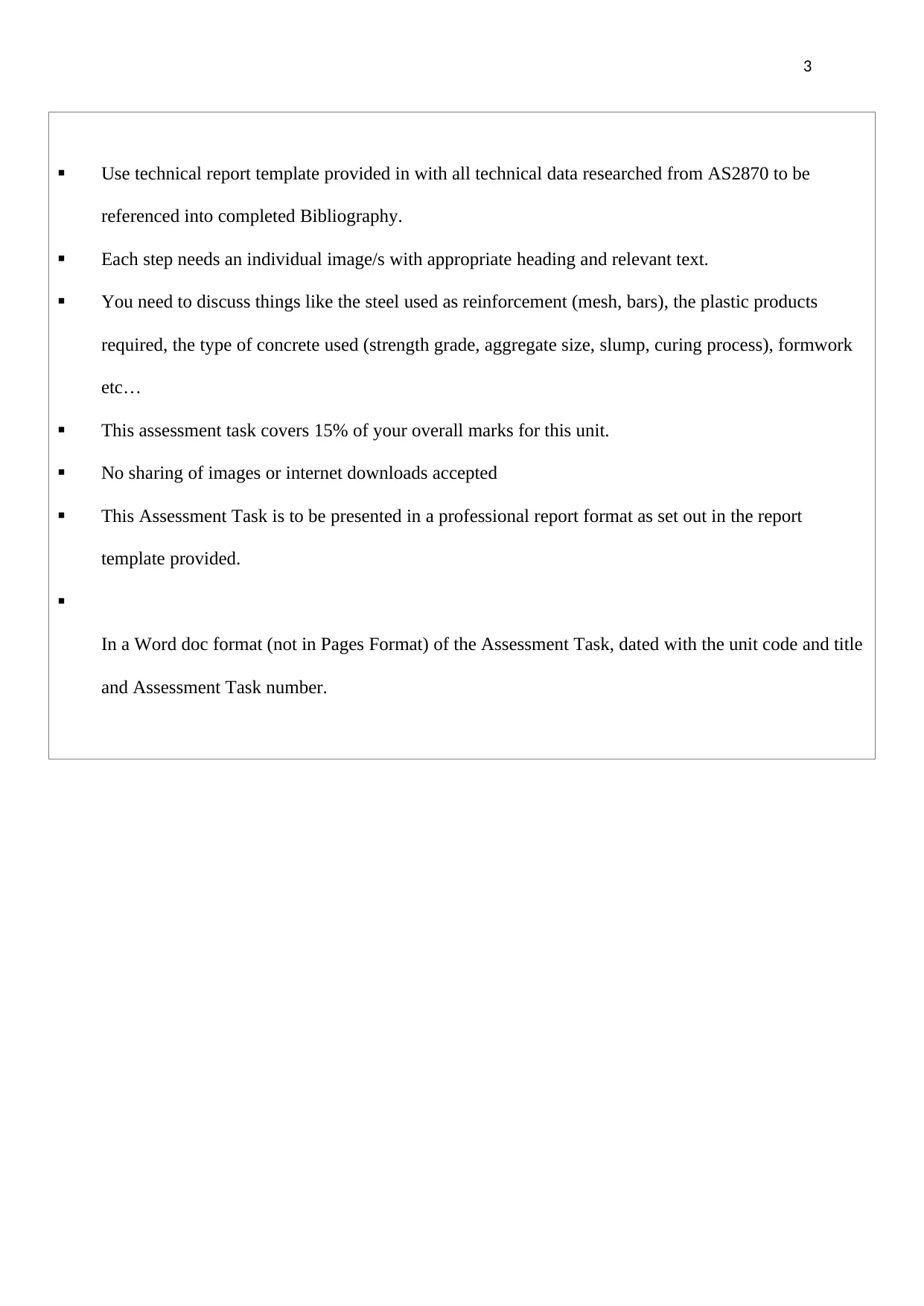
3
Use technical report template provided in with all technical data researched from AS2870 to be
referenced into completed Bibliography.
Each step needs an individual image/s with appropriate heading and relevant text.
You need to discuss things like the steel used as reinforcement (mesh, bars), the plastic products
required, the type of concrete used (strength grade, aggregate size, slump, curing process), formwork
etc…
This assessment task covers 15% of your overall marks for this unit.
No sharing of images or internet downloads accepted
This Assessment Task is to be presented in a professional report format as set out in the report
template provided.
In a Word doc format (not in Pages Format) of the Assessment Task, dated with the unit code and title
and Assessment Task number.
Use technical report template provided in with all technical data researched from AS2870 to be
referenced into completed Bibliography.
Each step needs an individual image/s with appropriate heading and relevant text.
You need to discuss things like the steel used as reinforcement (mesh, bars), the plastic products
required, the type of concrete used (strength grade, aggregate size, slump, curing process), formwork
etc…
This assessment task covers 15% of your overall marks for this unit.
No sharing of images or internet downloads accepted
This Assessment Task is to be presented in a professional report format as set out in the report
template provided.
In a Word doc format (not in Pages Format) of the Assessment Task, dated with the unit code and title
and Assessment Task number.
⊘ This is a preview!⊘
Do you want full access?
Subscribe today to unlock all pages.

Trusted by 1+ million students worldwide
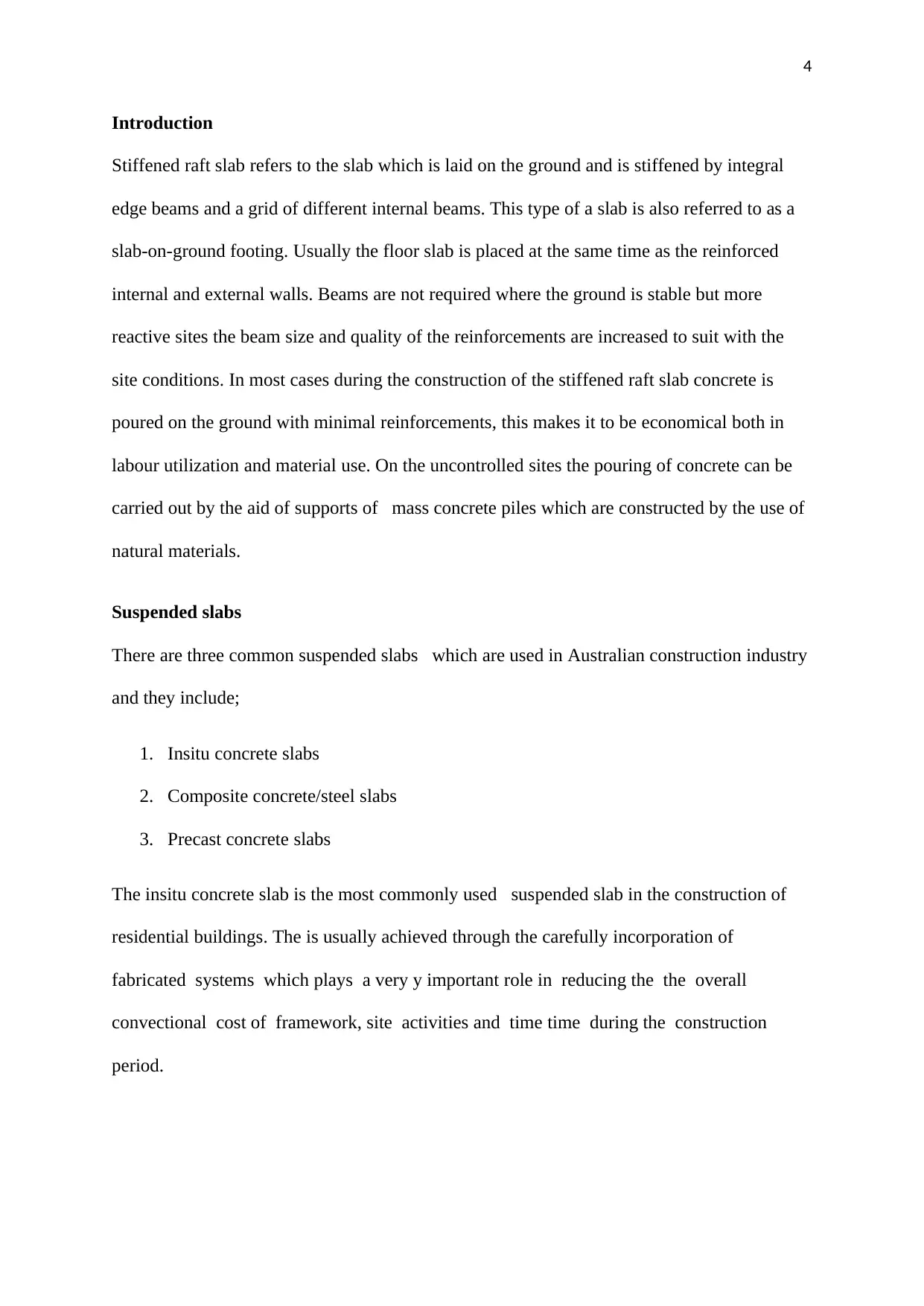
4
Introduction
Stiffened raft slab refers to the slab which is laid on the ground and is stiffened by integral
edge beams and a grid of different internal beams. This type of a slab is also referred to as a
slab-on-ground footing. Usually the floor slab is placed at the same time as the reinforced
internal and external walls. Beams are not required where the ground is stable but more
reactive sites the beam size and quality of the reinforcements are increased to suit with the
site conditions. In most cases during the construction of the stiffened raft slab concrete is
poured on the ground with minimal reinforcements, this makes it to be economical both in
labour utilization and material use. On the uncontrolled sites the pouring of concrete can be
carried out by the aid of supports of mass concrete piles which are constructed by the use of
natural materials.
Suspended slabs
There are three common suspended slabs which are used in Australian construction industry
and they include;
1. Insitu concrete slabs
2. Composite concrete/steel slabs
3. Precast concrete slabs
The insitu concrete slab is the most commonly used suspended slab in the construction of
residential buildings. The is usually achieved through the carefully incorporation of
fabricated systems which plays a very y important role in reducing the the overall
convectional cost of framework, site activities and time time during the construction
period.
Introduction
Stiffened raft slab refers to the slab which is laid on the ground and is stiffened by integral
edge beams and a grid of different internal beams. This type of a slab is also referred to as a
slab-on-ground footing. Usually the floor slab is placed at the same time as the reinforced
internal and external walls. Beams are not required where the ground is stable but more
reactive sites the beam size and quality of the reinforcements are increased to suit with the
site conditions. In most cases during the construction of the stiffened raft slab concrete is
poured on the ground with minimal reinforcements, this makes it to be economical both in
labour utilization and material use. On the uncontrolled sites the pouring of concrete can be
carried out by the aid of supports of mass concrete piles which are constructed by the use of
natural materials.
Suspended slabs
There are three common suspended slabs which are used in Australian construction industry
and they include;
1. Insitu concrete slabs
2. Composite concrete/steel slabs
3. Precast concrete slabs
The insitu concrete slab is the most commonly used suspended slab in the construction of
residential buildings. The is usually achieved through the carefully incorporation of
fabricated systems which plays a very y important role in reducing the the overall
convectional cost of framework, site activities and time time during the construction
period.
Paraphrase This Document
Need a fresh take? Get an instant paraphrase of this document with our AI Paraphraser
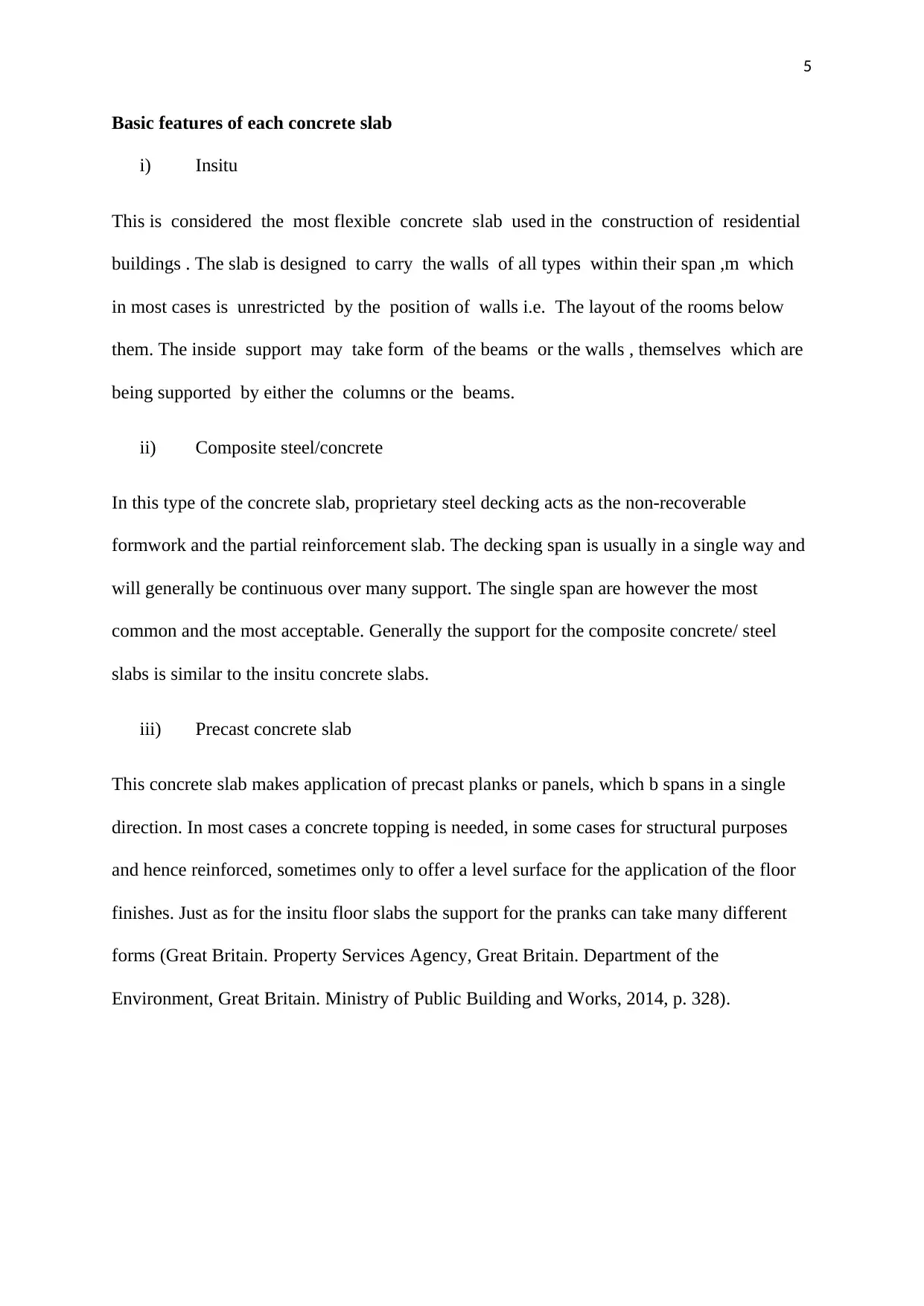
5
Basic features of each concrete slab
i) Insitu
This is considered the most flexible concrete slab used in the construction of residential
buildings . The slab is designed to carry the walls of all types within their span ,m which
in most cases is unrestricted by the position of walls i.e. The layout of the rooms below
them. The inside support may take form of the beams or the walls , themselves which are
being supported by either the columns or the beams.
ii) Composite steel/concrete
In this type of the concrete slab, proprietary steel decking acts as the non-recoverable
formwork and the partial reinforcement slab. The decking span is usually in a single way and
will generally be continuous over many support. The single span are however the most
common and the most acceptable. Generally the support for the composite concrete/ steel
slabs is similar to the insitu concrete slabs.
iii) Precast concrete slab
This concrete slab makes application of precast planks or panels, which b spans in a single
direction. In most cases a concrete topping is needed, in some cases for structural purposes
and hence reinforced, sometimes only to offer a level surface for the application of the floor
finishes. Just as for the insitu floor slabs the support for the pranks can take many different
forms (Great Britain. Property Services Agency, Great Britain. Department of the
Environment, Great Britain. Ministry of Public Building and Works, 2014, p. 328).
Basic features of each concrete slab
i) Insitu
This is considered the most flexible concrete slab used in the construction of residential
buildings . The slab is designed to carry the walls of all types within their span ,m which
in most cases is unrestricted by the position of walls i.e. The layout of the rooms below
them. The inside support may take form of the beams or the walls , themselves which are
being supported by either the columns or the beams.
ii) Composite steel/concrete
In this type of the concrete slab, proprietary steel decking acts as the non-recoverable
formwork and the partial reinforcement slab. The decking span is usually in a single way and
will generally be continuous over many support. The single span are however the most
common and the most acceptable. Generally the support for the composite concrete/ steel
slabs is similar to the insitu concrete slabs.
iii) Precast concrete slab
This concrete slab makes application of precast planks or panels, which b spans in a single
direction. In most cases a concrete topping is needed, in some cases for structural purposes
and hence reinforced, sometimes only to offer a level surface for the application of the floor
finishes. Just as for the insitu floor slabs the support for the pranks can take many different
forms (Great Britain. Property Services Agency, Great Britain. Department of the
Environment, Great Britain. Ministry of Public Building and Works, 2014, p. 328).
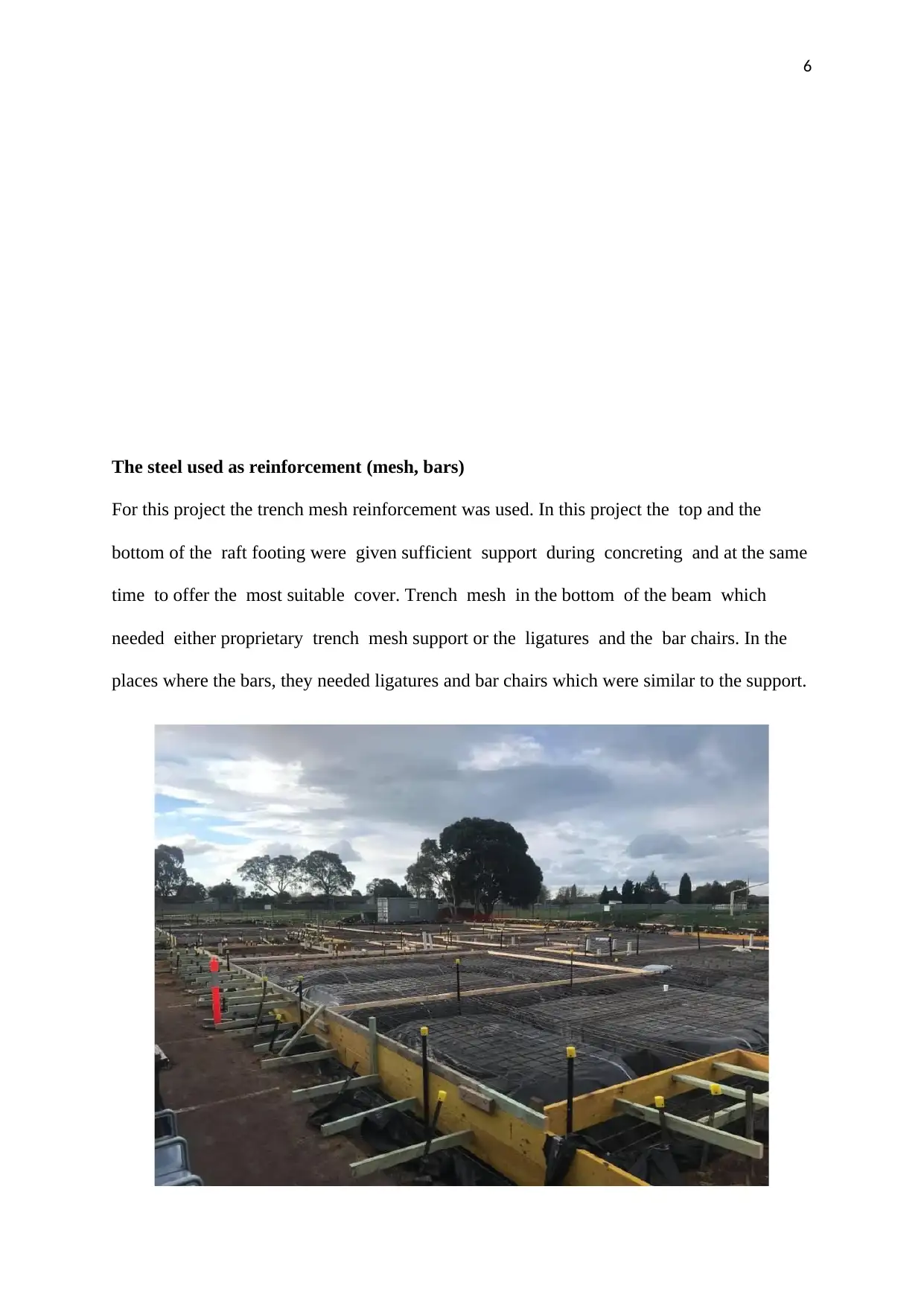
6
The steel used as reinforcement (mesh, bars)
For this project the trench mesh reinforcement was used. In this project the top and the
bottom of the raft footing were given sufficient support during concreting and at the same
time to offer the most suitable cover. Trench mesh in the bottom of the beam which
needed either proprietary trench mesh support or the ligatures and the bar chairs. In the
places where the bars, they needed ligatures and bar chairs which were similar to the support.
The steel used as reinforcement (mesh, bars)
For this project the trench mesh reinforcement was used. In this project the top and the
bottom of the raft footing were given sufficient support during concreting and at the same
time to offer the most suitable cover. Trench mesh in the bottom of the beam which
needed either proprietary trench mesh support or the ligatures and the bar chairs. In the
places where the bars, they needed ligatures and bar chairs which were similar to the support.
⊘ This is a preview!⊘
Do you want full access?
Subscribe today to unlock all pages.

Trusted by 1+ million students worldwide
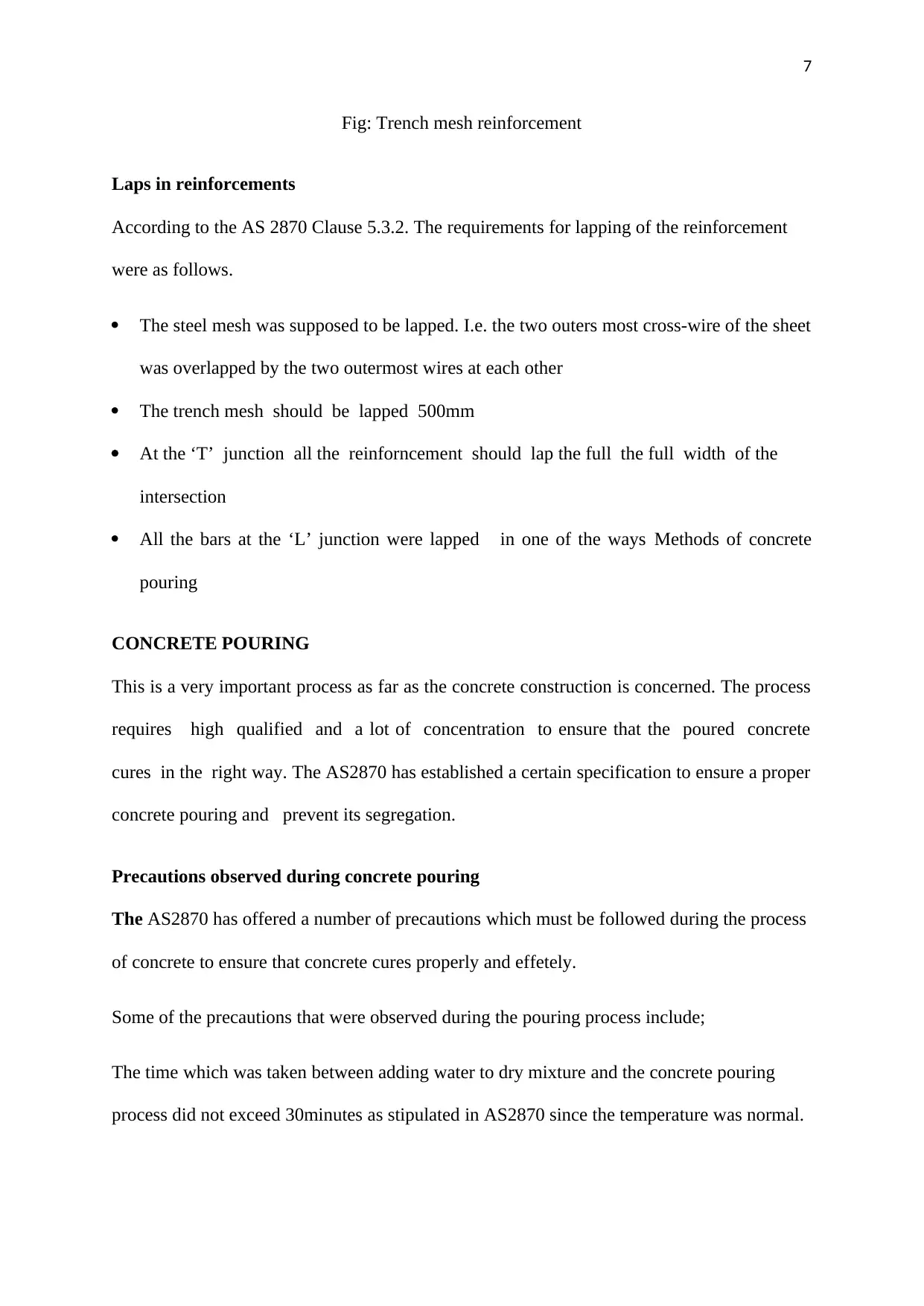
7
Fig: Trench mesh reinforcement
Laps in reinforcements
According to the AS 2870 Clause 5.3.2. The requirements for lapping of the reinforcement
were as follows.
The steel mesh was supposed to be lapped. I.e. the two outers most cross-wire of the sheet
was overlapped by the two outermost wires at each other
The trench mesh should be lapped 500mm
At the ‘T’ junction all the reinforncement should lap the full the full width of the
intersection
All the bars at the ‘L’ junction were lapped in one of the ways Methods of concrete
pouring
CONCRETE POURING
This is a very important process as far as the concrete construction is concerned. The process
requires high qualified and a lot of concentration to ensure that the poured concrete
cures in the right way. The AS2870 has established a certain specification to ensure a proper
concrete pouring and prevent its segregation.
Precautions observed during concrete pouring
The AS2870 has offered a number of precautions which must be followed during the process
of concrete to ensure that concrete cures properly and effetely.
Some of the precautions that were observed during the pouring process include;
The time which was taken between adding water to dry mixture and the concrete pouring
process did not exceed 30minutes as stipulated in AS2870 since the temperature was normal.
Fig: Trench mesh reinforcement
Laps in reinforcements
According to the AS 2870 Clause 5.3.2. The requirements for lapping of the reinforcement
were as follows.
The steel mesh was supposed to be lapped. I.e. the two outers most cross-wire of the sheet
was overlapped by the two outermost wires at each other
The trench mesh should be lapped 500mm
At the ‘T’ junction all the reinforncement should lap the full the full width of the
intersection
All the bars at the ‘L’ junction were lapped in one of the ways Methods of concrete
pouring
CONCRETE POURING
This is a very important process as far as the concrete construction is concerned. The process
requires high qualified and a lot of concentration to ensure that the poured concrete
cures in the right way. The AS2870 has established a certain specification to ensure a proper
concrete pouring and prevent its segregation.
Precautions observed during concrete pouring
The AS2870 has offered a number of precautions which must be followed during the process
of concrete to ensure that concrete cures properly and effetely.
Some of the precautions that were observed during the pouring process include;
The time which was taken between adding water to dry mixture and the concrete pouring
process did not exceed 30minutes as stipulated in AS2870 since the temperature was normal.
Paraphrase This Document
Need a fresh take? Get an instant paraphrase of this document with our AI Paraphraser
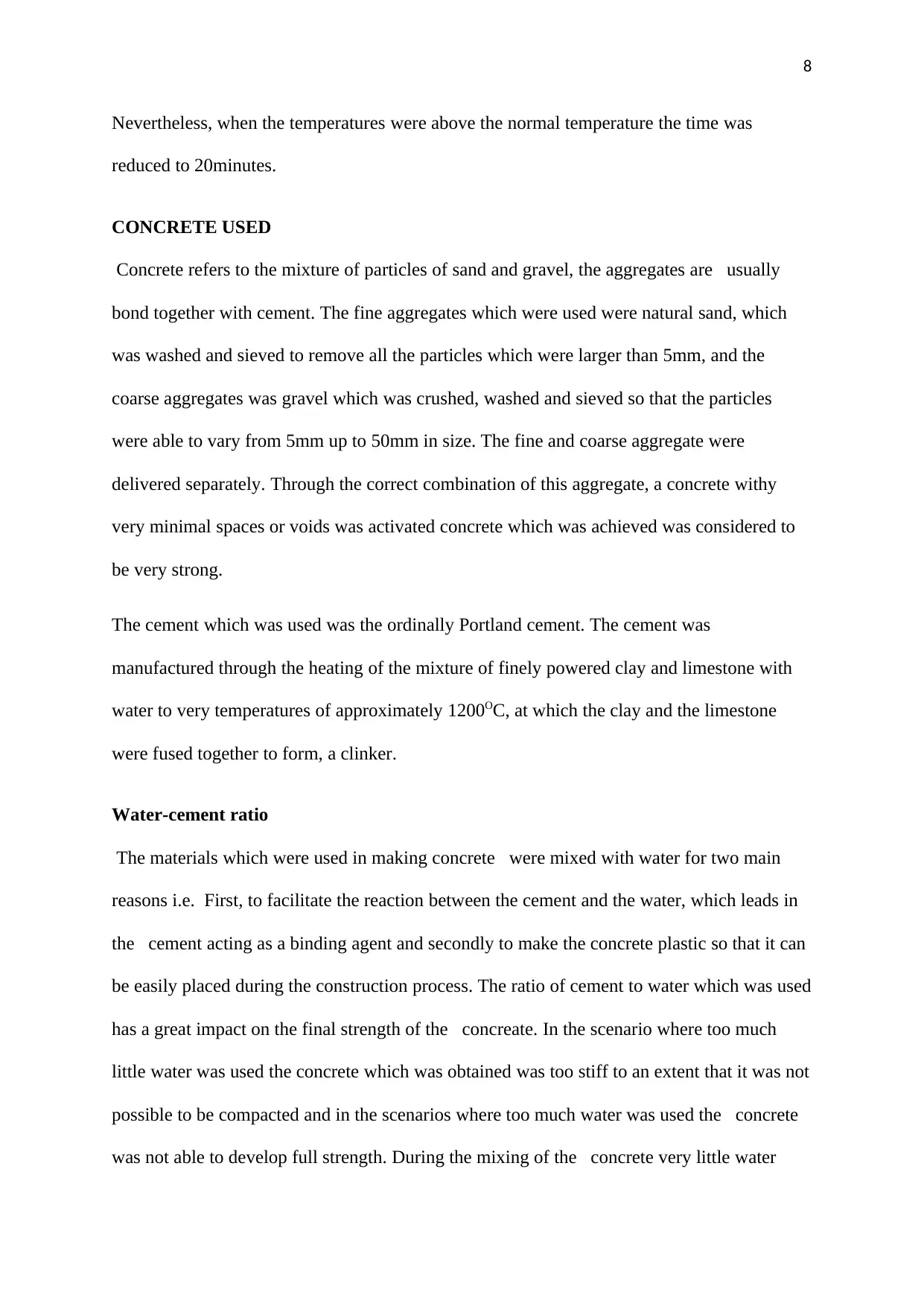
8
Nevertheless, when the temperatures were above the normal temperature the time was
reduced to 20minutes.
CONCRETE USED
Concrete refers to the mixture of particles of sand and gravel, the aggregates are usually
bond together with cement. The fine aggregates which were used were natural sand, which
was washed and sieved to remove all the particles which were larger than 5mm, and the
coarse aggregates was gravel which was crushed, washed and sieved so that the particles
were able to vary from 5mm up to 50mm in size. The fine and coarse aggregate were
delivered separately. Through the correct combination of this aggregate, a concrete withy
very minimal spaces or voids was activated concrete which was achieved was considered to
be very strong.
The cement which was used was the ordinally Portland cement. The cement was
manufactured through the heating of the mixture of finely powered clay and limestone with
water to very temperatures of approximately 1200OC, at which the clay and the limestone
were fused together to form, a clinker.
Water-cement ratio
The materials which were used in making concrete were mixed with water for two main
reasons i.e. First, to facilitate the reaction between the cement and the water, which leads in
the cement acting as a binding agent and secondly to make the concrete plastic so that it can
be easily placed during the construction process. The ratio of cement to water which was used
has a great impact on the final strength of the concreate. In the scenario where too much
little water was used the concrete which was obtained was too stiff to an extent that it was not
possible to be compacted and in the scenarios where too much water was used the concrete
was not able to develop full strength. During the mixing of the concrete very little water
Nevertheless, when the temperatures were above the normal temperature the time was
reduced to 20minutes.
CONCRETE USED
Concrete refers to the mixture of particles of sand and gravel, the aggregates are usually
bond together with cement. The fine aggregates which were used were natural sand, which
was washed and sieved to remove all the particles which were larger than 5mm, and the
coarse aggregates was gravel which was crushed, washed and sieved so that the particles
were able to vary from 5mm up to 50mm in size. The fine and coarse aggregate were
delivered separately. Through the correct combination of this aggregate, a concrete withy
very minimal spaces or voids was activated concrete which was achieved was considered to
be very strong.
The cement which was used was the ordinally Portland cement. The cement was
manufactured through the heating of the mixture of finely powered clay and limestone with
water to very temperatures of approximately 1200OC, at which the clay and the limestone
were fused together to form, a clinker.
Water-cement ratio
The materials which were used in making concrete were mixed with water for two main
reasons i.e. First, to facilitate the reaction between the cement and the water, which leads in
the cement acting as a binding agent and secondly to make the concrete plastic so that it can
be easily placed during the construction process. The ratio of cement to water which was used
has a great impact on the final strength of the concreate. In the scenario where too much
little water was used the concrete which was obtained was too stiff to an extent that it was not
possible to be compacted and in the scenarios where too much water was used the concrete
was not able to develop full strength. During the mixing of the concrete very little water
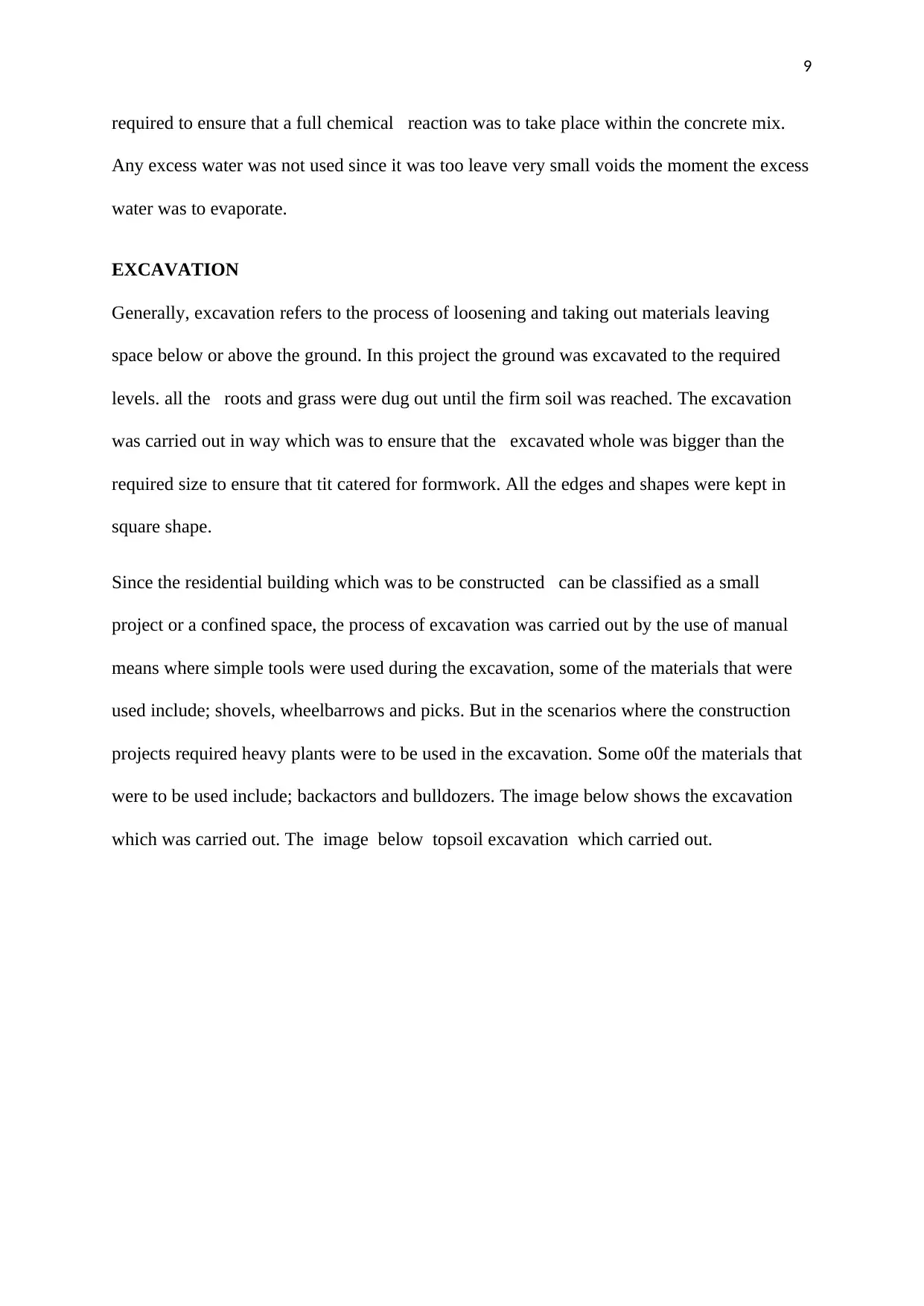
9
required to ensure that a full chemical reaction was to take place within the concrete mix.
Any excess water was not used since it was too leave very small voids the moment the excess
water was to evaporate.
EXCAVATION
Generally, excavation refers to the process of loosening and taking out materials leaving
space below or above the ground. In this project the ground was excavated to the required
levels. all the roots and grass were dug out until the firm soil was reached. The excavation
was carried out in way which was to ensure that the excavated whole was bigger than the
required size to ensure that tit catered for formwork. All the edges and shapes were kept in
square shape.
Since the residential building which was to be constructed can be classified as a small
project or a confined space, the process of excavation was carried out by the use of manual
means where simple tools were used during the excavation, some of the materials that were
used include; shovels, wheelbarrows and picks. But in the scenarios where the construction
projects required heavy plants were to be used in the excavation. Some o0f the materials that
were to be used include; backactors and bulldozers. The image below shows the excavation
which was carried out. The image below topsoil excavation which carried out.
required to ensure that a full chemical reaction was to take place within the concrete mix.
Any excess water was not used since it was too leave very small voids the moment the excess
water was to evaporate.
EXCAVATION
Generally, excavation refers to the process of loosening and taking out materials leaving
space below or above the ground. In this project the ground was excavated to the required
levels. all the roots and grass were dug out until the firm soil was reached. The excavation
was carried out in way which was to ensure that the excavated whole was bigger than the
required size to ensure that tit catered for formwork. All the edges and shapes were kept in
square shape.
Since the residential building which was to be constructed can be classified as a small
project or a confined space, the process of excavation was carried out by the use of manual
means where simple tools were used during the excavation, some of the materials that were
used include; shovels, wheelbarrows and picks. But in the scenarios where the construction
projects required heavy plants were to be used in the excavation. Some o0f the materials that
were to be used include; backactors and bulldozers. The image below shows the excavation
which was carried out. The image below topsoil excavation which carried out.
⊘ This is a preview!⊘
Do you want full access?
Subscribe today to unlock all pages.

Trusted by 1+ million students worldwide
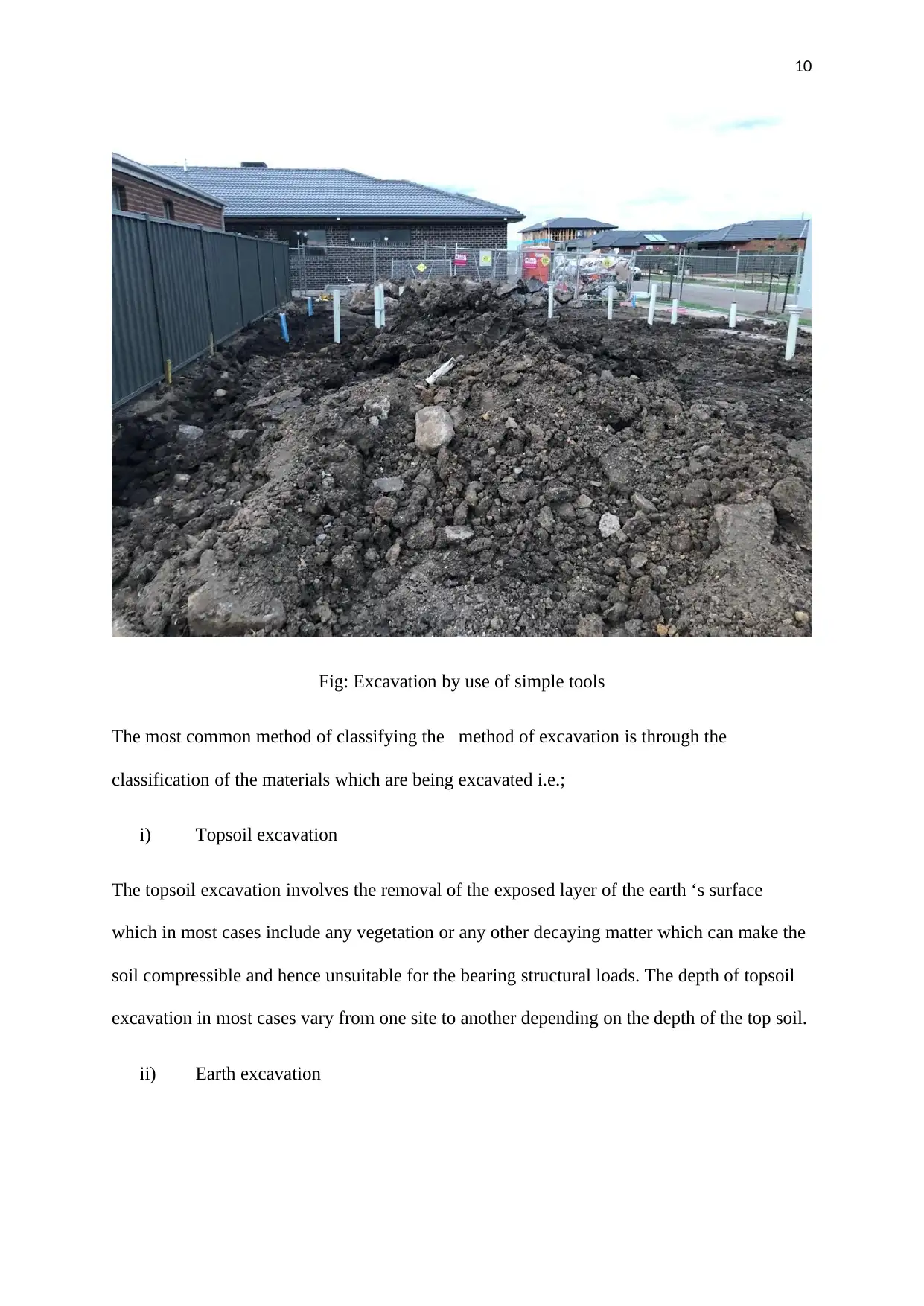
10
Fig: Excavation by use of simple tools
The most common method of classifying the method of excavation is through the
classification of the materials which are being excavated i.e.;
i) Topsoil excavation
The topsoil excavation involves the removal of the exposed layer of the earth ‘s surface
which in most cases include any vegetation or any other decaying matter which can make the
soil compressible and hence unsuitable for the bearing structural loads. The depth of topsoil
excavation in most cases vary from one site to another depending on the depth of the top soil.
ii) Earth excavation
Fig: Excavation by use of simple tools
The most common method of classifying the method of excavation is through the
classification of the materials which are being excavated i.e.;
i) Topsoil excavation
The topsoil excavation involves the removal of the exposed layer of the earth ‘s surface
which in most cases include any vegetation or any other decaying matter which can make the
soil compressible and hence unsuitable for the bearing structural loads. The depth of topsoil
excavation in most cases vary from one site to another depending on the depth of the top soil.
ii) Earth excavation
Paraphrase This Document
Need a fresh take? Get an instant paraphrase of this document with our AI Paraphraser
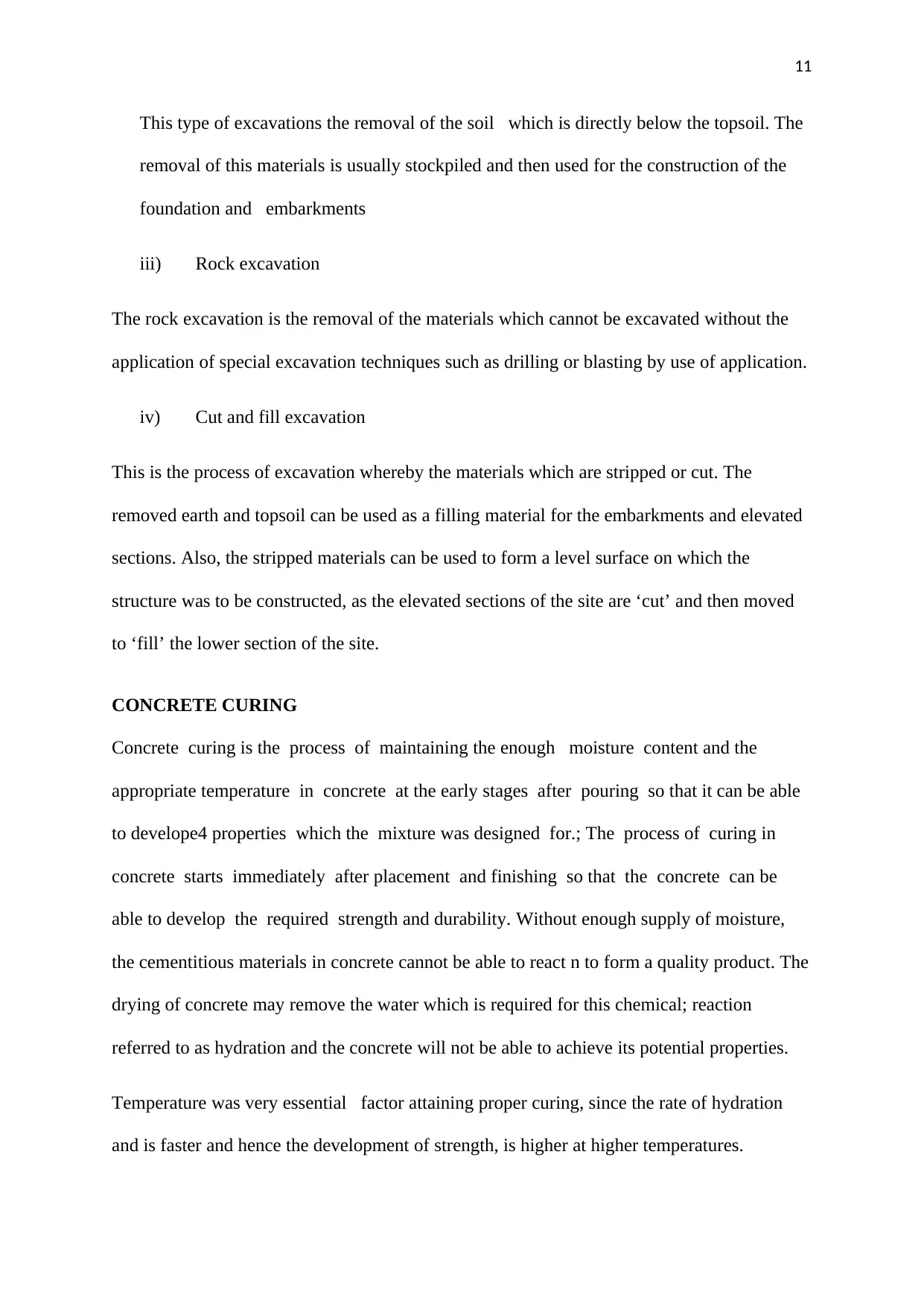
11
This type of excavations the removal of the soil which is directly below the topsoil. The
removal of this materials is usually stockpiled and then used for the construction of the
foundation and embarkments
iii) Rock excavation
The rock excavation is the removal of the materials which cannot be excavated without the
application of special excavation techniques such as drilling or blasting by use of application.
iv) Cut and fill excavation
This is the process of excavation whereby the materials which are stripped or cut. The
removed earth and topsoil can be used as a filling material for the embarkments and elevated
sections. Also, the stripped materials can be used to form a level surface on which the
structure was to be constructed, as the elevated sections of the site are ‘cut’ and then moved
to ‘fill’ the lower section of the site.
CONCRETE CURING
Concrete curing is the process of maintaining the enough moisture content and the
appropriate temperature in concrete at the early stages after pouring so that it can be able
to develope4 properties which the mixture was designed for.; The process of curing in
concrete starts immediately after placement and finishing so that the concrete can be
able to develop the required strength and durability. Without enough supply of moisture,
the cementitious materials in concrete cannot be able to react n to form a quality product. The
drying of concrete may remove the water which is required for this chemical; reaction
referred to as hydration and the concrete will not be able to achieve its potential properties.
Temperature was very essential factor attaining proper curing, since the rate of hydration
and is faster and hence the development of strength, is higher at higher temperatures.
This type of excavations the removal of the soil which is directly below the topsoil. The
removal of this materials is usually stockpiled and then used for the construction of the
foundation and embarkments
iii) Rock excavation
The rock excavation is the removal of the materials which cannot be excavated without the
application of special excavation techniques such as drilling or blasting by use of application.
iv) Cut and fill excavation
This is the process of excavation whereby the materials which are stripped or cut. The
removed earth and topsoil can be used as a filling material for the embarkments and elevated
sections. Also, the stripped materials can be used to form a level surface on which the
structure was to be constructed, as the elevated sections of the site are ‘cut’ and then moved
to ‘fill’ the lower section of the site.
CONCRETE CURING
Concrete curing is the process of maintaining the enough moisture content and the
appropriate temperature in concrete at the early stages after pouring so that it can be able
to develope4 properties which the mixture was designed for.; The process of curing in
concrete starts immediately after placement and finishing so that the concrete can be
able to develop the required strength and durability. Without enough supply of moisture,
the cementitious materials in concrete cannot be able to react n to form a quality product. The
drying of concrete may remove the water which is required for this chemical; reaction
referred to as hydration and the concrete will not be able to achieve its potential properties.
Temperature was very essential factor attaining proper curing, since the rate of hydration
and is faster and hence the development of strength, is higher at higher temperatures.
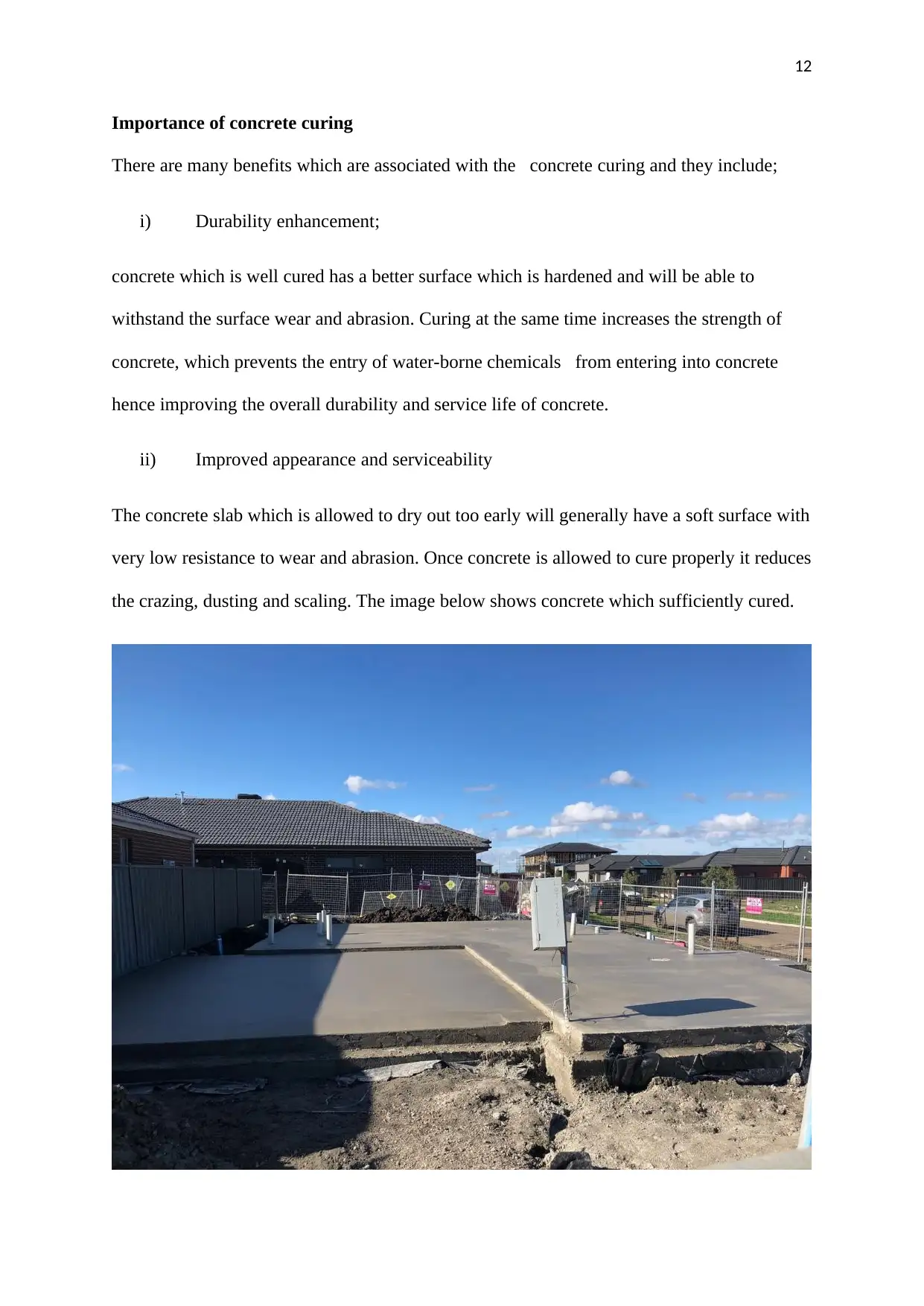
12
Importance of concrete curing
There are many benefits which are associated with the concrete curing and they include;
i) Durability enhancement;
concrete which is well cured has a better surface which is hardened and will be able to
withstand the surface wear and abrasion. Curing at the same time increases the strength of
concrete, which prevents the entry of water-borne chemicals from entering into concrete
hence improving the overall durability and service life of concrete.
ii) Improved appearance and serviceability
The concrete slab which is allowed to dry out too early will generally have a soft surface with
very low resistance to wear and abrasion. Once concrete is allowed to cure properly it reduces
the crazing, dusting and scaling. The image below shows concrete which sufficiently cured.
Importance of concrete curing
There are many benefits which are associated with the concrete curing and they include;
i) Durability enhancement;
concrete which is well cured has a better surface which is hardened and will be able to
withstand the surface wear and abrasion. Curing at the same time increases the strength of
concrete, which prevents the entry of water-borne chemicals from entering into concrete
hence improving the overall durability and service life of concrete.
ii) Improved appearance and serviceability
The concrete slab which is allowed to dry out too early will generally have a soft surface with
very low resistance to wear and abrasion. Once concrete is allowed to cure properly it reduces
the crazing, dusting and scaling. The image below shows concrete which sufficiently cured.
⊘ This is a preview!⊘
Do you want full access?
Subscribe today to unlock all pages.

Trusted by 1+ million students worldwide
1 out of 14
Related Documents
Your All-in-One AI-Powered Toolkit for Academic Success.
+13062052269
info@desklib.com
Available 24*7 on WhatsApp / Email
![[object Object]](/_next/static/media/star-bottom.7253800d.svg)
Unlock your academic potential
Copyright © 2020–2025 A2Z Services. All Rights Reserved. Developed and managed by ZUCOL.





